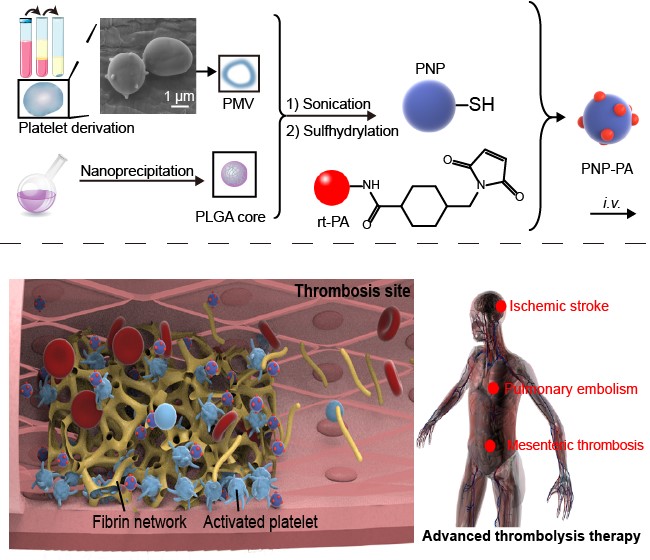Thrombus is a shared characteristic among various malignant diseases including myocardial infarction, ischemic stroke, pulmonary embolism and several malignant tumors. Key components of thrombi, such as platelets, fibrin and collagen, orchestrate the construction of the intravascular microenvironment in these diseases. Therefore, regulating (i.e., stimulating or eliminating) thrombi components could become an important vasculature targeting strategy. Prof. Nie’s Group has been focusing on regulating thrombi components strategies to overcome problems in nanomedicine-based therapy, including thrombin delivery strategy (Nature Biotechnology, 2018, 36, 258), platelets inhibition strategy (Nature Biomedical Engineering, 2017, 1, 667), collagen/fibronectin inhibition strategy (Nature Communications, 2018, 9, 3390), fibrin-fibronectin targeting strategy (Advanced Materials, 2019, 1906799), tissue factor silencing strategy (Nano Letters, 2019, 19, 4721) and platelet biomimetic drug delivery strategy (Advanced Materials, 2019, 31, 32) , etc.
More recently, a broad-spectrum advanced thrombolysis strategy was published on Advanced Materials (Engineered Nanoplatelets for Targeted Delivery of Plasminogen Activators to Reverse Thrombus in Multiple Mouse Thrombosis Models, DOI: 10.1002/adma.201905145). In order to solve the existing problems of the first-line thrombolytic drug, rt-PA (i.e., high bleeding risk, narrow therapeutic time window and short circulating time), platelet membrane was coated onto nanoparticle for the construction of rt-PA delivery platform, designated as PNP-PA. PNP-PA greatly prolonged the circulating time of rt-PA which benefited from the biomimetic modification. Moreover, PNP-PA showed strong targeting ability to thrombus site due to its preservation of multiple key receptors involved in thrombogenesis, including integrin αv?3, CD62p, GPVI, GPIbα, etc. Therefore, the pharmacodynamic behavior was also improved together with a significant decrease in its potential bleeding risk. This easy-made nanomedicine has shown potential effect in multiple murine thrombus models including ischemic stroke, pulmonary embolism and mesenteric vessel occlusion.
This collaborative work was accomplished by researchers from National Center for Nanoscience and Technology, Capital Medical University Affiliated Beijing Tiantan Hospital, China Pharmaceutical University and The First Affiliated Hospital of Soochow University. Prof. Guangjun Nie, Prof. Suping Li and Dr. Yinlong Zhang are the corresponding authors; Ph.D candidate Junchao Xu and Dr. Yinlong Zhang are the co-first authors.

Prof. Nie’s Group has been focusing on regulating thrombi components strategies to overcome problems in nanomedicine-based therapy, including thrombin delivery strategy (Nature Biotechnology, 2018, 36, 258), platelets inhibition strategy (Nature Biomedical Engineering, 2017, 1, 667), collagen/fibronectin inhibition strategy (Nature Communications, 2018, 9, 3390), fibrin-fibronectin targeting strategy (Advanced Materials, 2019, 1906799), tissue factor silencing strategy (Nano Letters, 2019, 19, 4721) and platelet biomimetic drug delivery strategy (Advanced Materials, 2019, 31, 32) , etc.
More recently, a broad-spectrum advanced thrombolysis strategy was published on Advanced Materials (Engineered Nanoplatelets for Targeted Delivery of Plasminogen Activators to Reverse Thrombus in Multiple Mouse Thrombosis Models, DOI: 10.1002/adma.201905145). In order to solve the existing problems of the first-line thrombolytic drug, rt-PA (i.e., high bleeding risk, narrow therapeutic time window and short circulating time), platelet membrane was coated onto nanoparticle for the construction of rt-PA delivery platform, designated as PNP-PA. PNP-PA greatly prolonged the circulating time of rt-PA which benefited from the biomimetic modification. Moreover, PNP-PA showed strong targeting ability to thrombus site due to its preservation of multiple key receptors involved in thrombogenesis, including integrin αv?3, CD62p, GPVI, GPIbα, etc. Therefore, the pharmacodynamic behavior was also improved together with a significant decrease in its potential bleeding risk. This easy-made nanomedicine has shown potential effect in multiple murine thrombus models including ischemic stroke, pulmonary embolism and mesenteric vessel occlusion.
This collaborative work was accomplished by researchers from National Center for Nanoscience and Technology, Capital Medical University Affiliated Beijing Tiantan Hospital, China Pharmaceutical University and The First Affiliated Hospital of Soochow University. Prof. Guangjun Nie, Prof. Suping Li and Dr. Yinlong Zhang are the corresponding authors; Ph.D candidate Junchao Xu and Dr. Yinlong Zhang are the co-first authors.

 Close Page
Close Page- Text Size: A A A
 Printer Friendly
Printer Friendly
